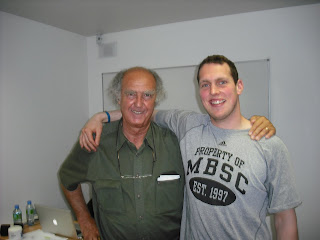
As my NMT Diploma nears its end, it was time for our class to spend its final weekend with Dr. Leon Chaitow.
This weekends topic was the European version lower extremity.
On Saturday we covered the basic table assessents for the lower extremity, and than applied MET methods to everything around the thighs.
Sunday was much the same with MET and PR techniques shown for the lower leg. We were also shown some nice joints mobilizations of the ankles and hips using METs.
I spoke to Dr. Chaitow about reading Gray Cooks new book "Movemnet". I would really like to get his opinion on Grays philosphy.
I question the use of table assessents as a main assessment of a patient as opposed to an assessment of movement patterns (FMS, SFMA, Sahrmann). Now some table assessments can come in handy, like in the SFMA breakouts to determine if a problem is a mobility or stability one.
I am a believer in Grays thought process that hypertonic muscles, are primer movers being ask to also be primary stabilizers, as the timing (not strength) efficency of the actually prime stabilizers is off.
Example would be when timing of the deep inner core unit (multifidus, TVA, etc)is off and the body will compensate as a protective mechanism by getting the muscles around the pelvis to become hypertonic in an attempt to keep the spine and pelvis stable.
This is how a stability or motor control issue can make it seem like a person has a mobility or flexibility issue when they do not.
Remember mobility problems are consistent. Stability problems are inconsisent.
I hope Dr.Chaitow will read Grays book soon.
Stay Strong,
RB
You can't argue with the results that manual therapists have had with the use of table assessments versus movement based assessments.
ReplyDeleteThat isn't a knock on the movement based assessments, but rather praise for the table assessments.
I mean, something could be hypertonic because of what you said, but what of say, hypertonic spinal erectors? Their job is to stabilise, is it not? Although you could argue their job is to extend, it's kind of like rectus abdominus, I see it as they are resisting flexion, as oppsosed to creating extension. Deadlift versus hyperextension kind of thing.
Sometimes it is just as simple as they have done more work than they can handle, and the stress response has overwhelmed the tissue.
Sometimes it isn't that simple.
Gray is brilliant, but a lot of what he says isn't new stuff, it is stuff osteopaths have been doing for a long time. He is just explaining the whys a lot better.
I disagree that a table assessment should be your first plan of action. I think table assessments are part of the puzzle.
ReplyDeleteI know Gray didnt come with these concepts. Most of them are from Janda and Lewit and DNS, and some others no doubt, and you are right in that Gray just spells it out better.
But nothing that I have come across compares to Grays thought process on corrective strategies.
Also yes manaul therapist can get great results on the table, but if they dont follow their table treatment up with some form of movement re-education the effects of the treatment are short lived in most cases. This is also where Gray is ahead of others in my mind.
Good discussion.
Yeah, I agree wholeheartedly about following up the manual treatment with exercises or movement re-education.
ReplyDeleteI know that Gray says something along the lines of: is the glute medius dysfunction causing the poor squat or is it the other way around.
I know that all muscles are under a central control, but also, those same muscles have local chemical reactions etc. that can initiate the dysfunction leading to the lesion being maintained/worsened by central nervous system factors.
I haven't read Gray's new book, just Athletic Body In Balance, I might give it a read after my exams finish, to check out his corrective strategies.
We are on the same side, I just like to discuss for the sake of discussion. If you have to defend your viewpoint, you learn to really understand it, or change it.
Keep up the good work.
Thanks Nick.
ReplyDeleteGood stuff my man.
RB